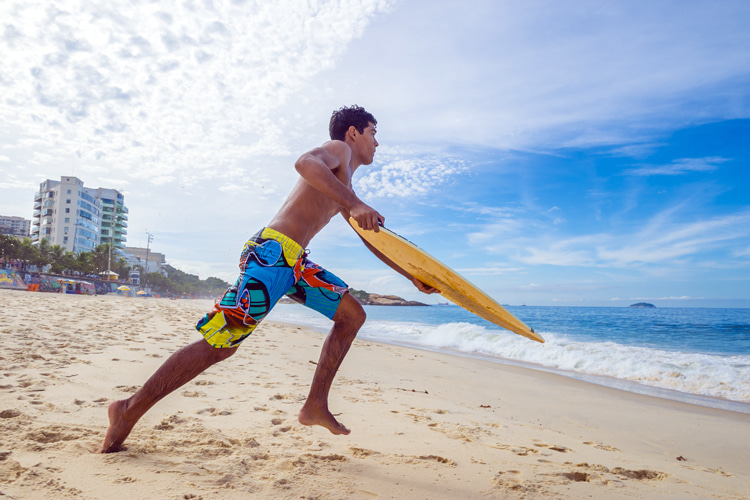Skimboarding is a highly versatile sport that can be practiced and enjoyed both in and out of the water.
A skimboard is a finless, solid, and smooth plank that can be ridden in shore break waves and also inland, wherever there's a thin layer of water.
The sport has two main disciplines - wave and flatland skimboarding - with different requirements when it comes to equipment.
As a result, there are two types of skimboards: foam and wood skimboards.
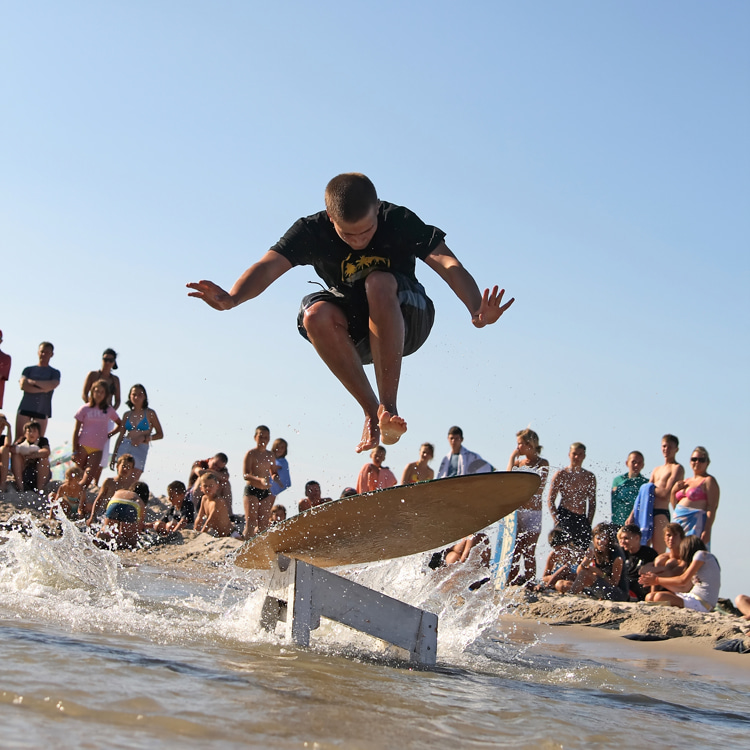
Wood Skimboards
Wood skimboards are only used for flatland skimboarding.
While you can ride one out into small waves, they are too heavy and prone to sinking to do anything legit in large shore-breaking waves.
But that is not what they are intended for, so forget about it.
Wood skimboards are super durable and solid, built to shred rails and slide and pop in all sorts of conditions.
In these conditions, a foam-based skimboard wouldn't stand a chance.
Skimboards made from wood can be made out of a variety of materials.
The most common woods used in skimboard shaping are mahogany plywood or birch.
They are much shorter, poppier, thinner, and yet heavier than their floaty foam cousins.
While there is quite a variety when it comes to shapes and styles of wooden boards, here are a few main attributes you will probably need to know depending on your style:
1. Sizes
First of all, choose a skimboard that fits your height and weight requirements.
A board too big will be too difficult to maneuver; a board too small won't hold your weight, and you will spend more time in the sand than in the water.
Then, figure out what type of flatland skimming you want to do - fast, long rides, or quick tricks.
For fast, long rides, you will want a longer board, and for tricks, get a shorter one.
Typically, getting the smallest board you can manage in your height/weight range is best. This will give you good speed with lots of control.
2. Rocker
This will also depend on the type of skimming you prefer - fast, long rides require boards with less rocker or pop.
Most flatland skimmers, however, prefer wooden skimboards with lots of pop to execute a variety of tricks easily.
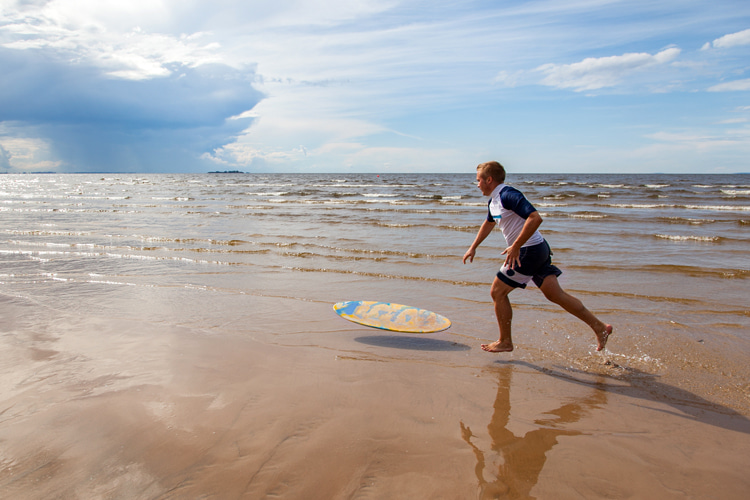
3. Weight
Usually, it's preferred to have a heavier woody for durability and control.
A board that's too light will have a tendency to fly in undesired directions and will be more prone to snapping.
Considering the hard abuse these boards endure, they need to be good and solid.
4. Shapes
Wood skimboards come in a wide variety of shapes, and there isn't a right or wrong, just whatever you prefer.
Certainly, some shapes are better suited for certain styles.
Long oval shapes or teardrops are good for long, fast slides along a smooth sandy shore. Shorter and wider are great for hitting rails and tricks.
Many riders prefer wooden skimboards that are slightly narrower in the nose and tail and graduate wider in the middle.
Why? Because they are really poppy and they cut through the water nicely.
Also, riders find they ride well no matter which way the board is facing, front or back.
As mentioned above, wooden skimboards come in many shapes and sizes.
The most common ones are long, rounded, or squared oval shapes, teardrops, or short and squat with a narrower nose and tail and a wider middle.
To Shape or Not to Shape
Do you want to make your own board? Please don't do it to save money but rather for the sheer joy of making it yourself.
It takes time and can be costly - don't expect to make a great board on your first try.
People who excel at manufacturing boards have had years and years of practice and experience, with many failures along the way.
Nevertheless, it can be super fun and rewarding to get out and ride a skimboard shaped by your hands.
Check out how to make a skimboard for some advice and ideas on how to do this.
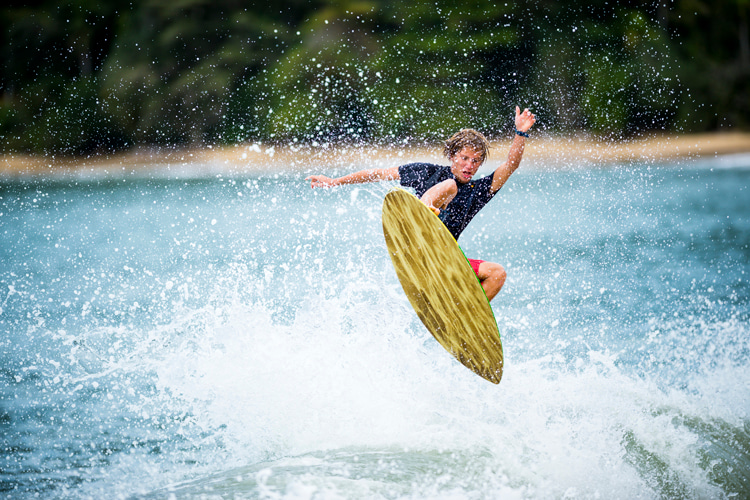
Foam Skimboards
Foam skimboards are lightweight boards made specifically for riding waves. These wave boards are often dubbed "foamies" due to their foam core.
Of course, there is much more to them than just foam.
These are the most technical style of boards, and while they don't vary too much in shape - as wooden skimboards do - they do come in a variety of technical levels, from beginner to intermediate to advanced.
Foam skimboards also cost considerably more because they are more difficult and expensive to make.
Because of this, it may be tempting to go out and buy the most advanced board when you are learning, but don't - you will go through many boards by the time you get to that level.
Be honest with yourself and your skimming abilities when purchasing a new board. There is a reason they come in different ability levels.
An advanced board will be far too stiff and curvy for a beginner, while a pro rider will, naturally, find a beginner board too big and unresponsive.
Foam-based skimboards will have four essential characteristics specific for riding a variety of waves:
Weight: they must be light enough to practically float - or skim - on the water but heavy enough that they don't fly away in the wind;
Speed: skimmers need speed to get to the desired wave, or they will miss it completely.
Rocker: this is where the board bends upwards at the nose, allowing it to cut easily through the water with a slight lift in the tail for control. The degree of rocker will usually depend on where you ride, but is mostly a personal preference;
Flexibility: a slightly flexible board is less prone to snapping than a stiff board, but it is slower. Again, this is mainly a personal preference based on your riding level and style;
1. Sizes
Yes, size does matter. At least it does when it comes to foam skimboards.
If you want to get a new board, start with the one that fits your height and weight requirements.
A board too big will be too difficult to maneuver; a board too small won't hold your weight, and you will spend more time in the sand than on the water.
Next, figure out what type of wave skimming you want to do.
Are you a soul surfer skimmer, gracefully carving long smooth curves? Or do you prefer the new school style, shredding hard and busting quick tricks?
A longer board will give you those long smooth curves as they are faster and make wider turns.
For a responsive board that turns easily, get a shorter one even though it is slightly slower.
Typically, it is best to get the smallest board in your height/weight range that you can manage. This will give you good speed with lots of control.
The thickness of the board will also have an effect on how fast/maneuverable the board is.
The thicker it is, the faster and farther it will go, but then it will also be heavier and, of course, harder to navigate.
The most common foamie skimboards are 3/4 in or 5/8 in thick.
There are a couple of other considerations.
Bigger, faster, more powerful waves will give you lots of speed; smaller, weak waves won't.
So here is where the above advice differs a little.
If you want to go faster in small, weak waves, go for a slightly bigger board, or you'll never even get to it.
Naturally, if you're in a spot where you can hit a big powerful wave, go for a slightly smaller board that maneuvers better because you already got the speed.
Finally, analyze how fast you run - for reals.
Obviously, if you run faster, you can get away with a smaller board.
The slower you run, the faster (aka, bigger) your board needs to be.
Again, be honest with yourself. Nobody cares, but your riding performance will suffer if you pretend to be something you're not - or at least not yet.
That said, some people prefer to run slower, so they expend less energy, and they can ride longer.
2. Materials
Foam skimboards are made using a variety of materials intended to achieve a particular performance.
The term "foamie" comes from the foam used for the core.
The majority of manufacturers use a closed-cell foam, which is a high-density foam material that resists water absorption and dings, unlike the super light, super absorbent foam of a surfboard.
If you do ding your board, it is not super critical to get out of the water right away.
That said, you will still need to get it repaired sooner than later.
Fiberglass is used for the strong outer shell.
There are a few different types of fiberglass that come in a variety of weaves and weights.
A looser weave will result in a more flexible board which will be less liable to snapping but at the cost of being slower.
A tight weave will produce a much stiffer, faster board which can also tend to snap easily.
Heavier weaves are stronger but heavier than lighter-weight weaves.
Carbon is a very high-end type of fiberglass that is very stiff and very strong, hence a very fast board.
Foam skimboards made with carbon fiber are often the fastest boards around, but they are considerably more expensive and easy to snap.
Quite often, board makers will use two or three layers of different weaves of fiberglass to achieve optimal performance, speed, and strength.
Of course, the fiberglass needs to stick to the foam core somehow, which is done using a type of resin, which is basically a form of glue.
Again, there are a few varieties: polyester, vinyl ester, and epoxy.
Polyester is the cheapest and easiest to use as it is stiff and hard.
Vinylester is slightly softer but is more tolerable to scratches from rocks and shells, etc.
Epoxy is the most expensive and most difficult to work with. However, it is considered to be the best.
It is the softest of all the resins and is the strongest, making it the most enduring to abrasions.
As mentioned, it is very hard to work with as it is incredibly sticky and takes forever to dry.
Chances are, if your skimboard is made of carbon, it will also be made using epoxy as they play nice together.
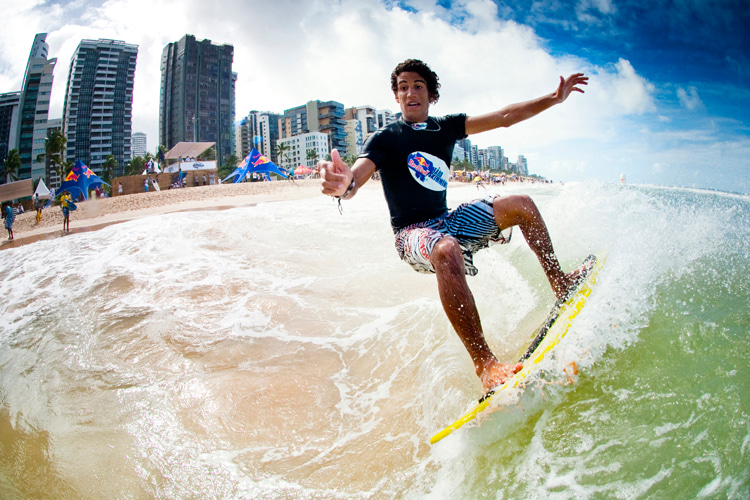
3. Shapes
Foamie skimboards are essentially very similar in shape. The main variations are in the tail.
The most popular is the pin-tail shape, which is a simple, pointed end.
This gives the skimmer a lot of control, and stability and is perfect for wave wrapping.
Another common style is the "fish" tail, which looks like a W.
This design, which has been a favorite of surfers for years, is incredibly responsive and gives off fantastic spray.
For an even more spectacular spray, go for a board with a squared-off tail, so it is just flat at the end.
There are also differences in the board's rail and rocker.
Turned-down rails will cut through the water faster but can also be easier to catch an edge, while more rounded rails will be floatier.
Rocker, as mentioned, is the lengthwise curve of the board that gives it its pop.
More rocker gives more pop and is slower; less rocker provides less pop and is faster.
Skimboard Shaper: Trust and Knowledge
It's true that wooden skimboards are cheaper than foam skimboards, but if you are looking for a cheap board, good luck with that.
Don't expect your board to last long or perform very well, and certainly don't expect anyone to take you for real. You get what you pay for.
If you are serious about skimboarding, buy a proper board from a reputable maker - boards made by people who actually skim.
Just remember, everyone has their own opinion of what is good and what's not.
There is no right or wrong - just keep in mind what you like and what your style is.
Advice is just that - advice. It's good to get it but keep an open mind.
There are several stick makers creating the best wooden skimboards available. And foam skimboards are not - or easy - cheap to make.
Some companies are bigger and have been around as long as skimboarding has; some are just a couple of passionate people, still making boards in their garage, but all of them make high-quality products.
None of the quality skimboards are made in large factories in mass production, so a lot of care has been put into each and every board.
And this is just the beginning.
Once the board has been carefully crafted, then even more love goes into it with sweet graphics from a variety of talented artists.
The best high-quality foam and wood skimboard manufacturers are DB Skimboards, Victoria Skimboards, Exile Skimboards, Zap Skimboards, and Folha Skimboards.
Words by Nicole Rigler | Skimboarder
